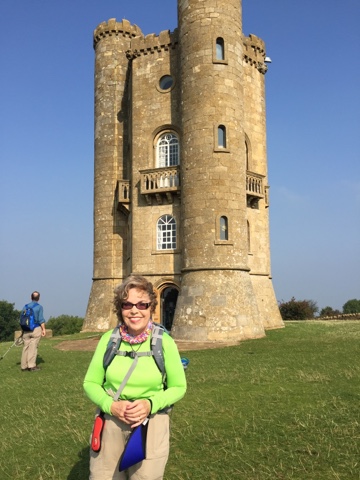This morning we were transported 20 minutes to the nearby village of Broadway to begin our 5.5 mile hike.
The hike was notable for several reasons. First we climbed up a hill where we had great views of Broadway. We continued our climb up 700 feet across grassland to Dover's Hill, the second highest point in the Cotswolds at 1,025 ft. We were treated to a stop at Broadway Tower, a small Saxon-looking castle known as a "folly," an extravagant building constructed for no real practical reason except to impress others with one's wealth. It was built in 1798 by the famous 18th century architect James Wyatt for the Earl of Coventry.
Then the trail entered some woods for awhile and then out into farmland. Some of it was so rocky we couldn't imagine how you could grow anything,
but we were later told it was bad for root vegetables but great for grains.
We reached Chipping Camden around 1 and passed by houses with wonderful flowers in their front yards.
Chipping Camden is a small market town, once the home of the richest Cotswold wool merchants. The buildings along its well preserved High Street date from the 14th century to the 17th century.
We gathered at the Market Hall, built in 1627 for the sale of local produce. The rafters and floor are original and the roof is limestone shingles. These shingles were used all over the region. The market was taken over by the National Trust in 1942 to preserve.
We had lunch on our own (we at the old Silk Mill, home of the old Artists' Guild)and regrouped for a group tour. We walked around the city, looking at the architecture and historical landmarks. We visited a silversmith, who is the great grandson of William Hart. He was one of the artisans who followed Charles Robert Ashbee when he moved his Guild of Handicraft, an off shoot of the Arts and Crafts movement, from London to here in 1902.
I've never been to a silversmith's workshop and was overwhelmed with the number of tools -- something like 700 -- most of which seemed in disarray. But Hart does specialty commission work, for the government or very wealthy people, so he stays in business. He apprenticed for 7 years before taking over the business.He only had 2 others working for him - one as intense as he.
Then we walked around the city, looking at buildings and ending the tour at St. James Church, considered one of the finest churches in the Cotswolds and built by wool wealth. Next to it is the gate to the former estate of Baptist Hicks, Lord of the Manor, where the remains of his mansion survive. It was burned by royalists in 1645 and never rebuilt. (Cemetery in adjacent church yard.)
We headed back to the hotel at 5:00, had another 3-course gourmet dinner and then a lecture on farming in the Cotswolds. It's definitely off to bed!




















No comments:
Post a Comment